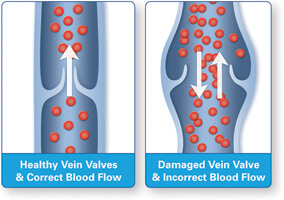Vein Conditions
Chronic Venous Insufficiency (CVI)

Problems due to vein disorders usually occur when the one-way valves in veins fail to work properly. This results in poor venous circulation with inflammation, a high back pressure in the veins, and even clotting.
Chronic Venous Insufficiency (CVI) is a condition that occurs when the venous wall and/or valves in the leg veins are not working effectively, making it difficult for blood to return to the heart from the legs. CVI causes blood to “pool” in the veins, and this pooling is called stasis.
What are the Symptoms of Chronic Venous Insufficiency?
Signs of chronic venous insufficiency can include the development of:
- Ankle/leg swelling (Edema)—Stage 1 CVI
- Chronic Stasis Dermatitis/Skin Inflammation—Stage 2 CVI
- Venous Ulceration (Active/Healed)—Stage 3 CVI
More severe signs of chronic venous insufficiency are enlarging Varicose Veins, venous bleeding, Restless Leg Syndrome, worsening swelling, increasing pain & tenderness, venous stasis skin changes, Thrombophlebitis, Deep Vein Thrombosis DVT, and Leg Venous Ulcers.
What causes Chronic Venous Insufficiency?
Veins return blood to the heart from all the body’s organs. To reach the heart, the blood needs to flow upward from the veins in the legs. Calf muscles and the muscles in the feet need to contract with each step to squeeze the veins and push the blood upward. To keep the blood flowing up, and not back down, the veins contain one-way valves.
Chronic venous insufficiency occurs when these valves become damaged, allowing the blood to leak backward. Valve damage may occur as the result of aging, extended sitting or standing or a combination of aging and reduced mobility. When the veins and valves are weakened to the point where it is difficult for the blood to flow up to the heart, blood pressure in the veins stays elevated for long periods of time, leading to CVI.
What are the risk factors for chronic venous insufficiency?
If you have risk factors for CVI, you are more likely than other people to develop the disease. The most important risk factors are:
- Heredity – Family history of varicose veins
- Obesity
- Pregnancy
- Inactivity – Sedentary Lifestyle
- Smoking
- Standing – Extended Time on Your Feet
- Female
- Age over 50
An estimated 40-percent of people in the United States have CVI. It occurs more frequently in people over age 50, and more often in women than in men.
Next Steps
Are you concerned that you might have Chronic Venous Insufficiency? Use the form below to request a consultation or call us at 317-348-3020. We look forward to hearing from you!
